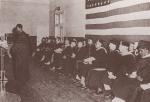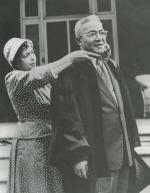![header=[Marker Text] body=[Chartered as Ashmun Institute, April 29, 1854. Founded by Rev. John Miller Dickey for the purpose of providing liberal higher education for people of African ancestry in America. In 1866, it became Lincoln University, interracial and international. ] sign](http://explorepahistory.com/kora/files/1/10/1-A-37F-139-ExplorePAHistory-a0m0v8-a_450.jpg)
Mouse over for marker text
Name:
Lincoln University
Region:
Philadelphia and its Countryside/Lehigh Valley
County:
Chester
Marker Location:
SR 3026 (old U.S. 1), 2 miles NE of Oxford
Dedication Date:
January 25, 1967
Behind the Marker
More than a half-century before  W.E.B. Du Bois coined the phrase the "talented tenth," a reference to elite leadership within the African-American community, a small school opened in rural Chester County intent on realizing that very ideal. Conceived initially as a training school for the foreign missions, the Ashmun Institute grew beyond its provincial setting into a modern university dedicated, in the words of Horace Mann Bond, to offering an "education for freedom." Among its many accomplishments, present-day Lincoln University claims to be the first institution anywhere in the world to offer a higher education to people of African descent.
W.E.B. Du Bois coined the phrase the "talented tenth," a reference to elite leadership within the African-American community, a small school opened in rural Chester County intent on realizing that very ideal. Conceived initially as a training school for the foreign missions, the Ashmun Institute grew beyond its provincial setting into a modern university dedicated, in the words of Horace Mann Bond, to offering an "education for freedom." Among its many accomplishments, present-day Lincoln University claims to be the first institution anywhere in the world to offer a higher education to people of African descent.
Founded by local Presbyterian minister John Miller Dickey with the support of the governing New Castle (Delaware) Presbytery, the Ashmun Institute opened in the spring of 1854, just as the nation was plunging into the deep political turmoil that would lead to the outbreak of the Civil War.
Just three years earlier in nearby Christiana, black and white townsfolk had taken up arms to prevent the return of fugitive slaves to their Maryland plantation master. The so-called Christiana Riot some say Resistance) gained national attention for the anti-slavery cause and may have influenced Dickey's resolve to open a school steeped in the classical tradition and committed to equal educational opportunity.
Christiana Riot some say Resistance) gained national attention for the anti-slavery cause and may have influenced Dickey's resolve to open a school steeped in the classical tradition and committed to equal educational opportunity.
Named in honor of Rev. Jehudi Ashmun (1794-1828), an agent of the African Colonization Society, the Institute was one of a handful of church-affiliated black colleges to prosper before the Civil War. Out of respect for the slain president, trustees in 1866 renamed the private school Lincoln University.
Several things distinguished Lincoln University from the start. First was its location just north of the Mason-Dixon Line, the proverbial boundary between slavery and freedom in antebellum America. Its founders were committed to the "elevation of an intellectual elite, divinely ordained, through whom would be exercised on the lower classes among their fellows, the saving grace of God's plan for redemption."
In a careful blending of theological and classical imagery, Ashmun/Lincoln's mission was to be a citadel of race pride and leadership extending around the world. Finally, through higher education, African Americans were to discover a sense of individual purpose and civic responsibility far different than they would receive from the vocational training advocated elsewhere.
As an elite institution for men, Lincoln's academic reputation and international outreach continued well into the twentieth century. Both literally and figuratively Lincoln brought the world to its students and its students to the world. Famous alumni included activists Archibald and Francis Grimke (1870), educator Horace Mann Bond ('23), poet Langston Hughes ('26), and Supreme Court Justice Thurgood Marshall ('30).
Horace Mann Bond returned with a doctorate in hand to serve as Lincoln's first African-American president from 1945 to 1957. His son Julian remembered as a child meeting Albert Einstein at a campus reception hosted by his father in 1946.
True to its historic Pan-African mission, Lincoln has also educated generations of influential African leaders, including Kwami Nkrumah ('30) Nmadi Azikiwe ('30), and Sibusio Nkomo ('81). In 1950, Lincoln University received primary responsibility for an extraordinary art collection amassed by Philadelphia scientist and entrepreneur Albert C. Barnes.
Symbolically, coincidental to the ninetieth anniversary of the Emancipation Proclamation and the eve of its own centennial celebration, Lincoln in 1952 admitted its first class of female students.
Two decades later, the Commonwealth of Pennsylvania assumed control and Lincoln University became a state-related or Commonwealth university. Enrolling approximately 2,000 undergraduate and graduate students in two-dozen degree programs, Lincoln University continues to thrive as Pennsylvania's oldest historically black institution of higher education.
Founded by local Presbyterian minister John Miller Dickey with the support of the governing New Castle (Delaware) Presbytery, the Ashmun Institute opened in the spring of 1854, just as the nation was plunging into the deep political turmoil that would lead to the outbreak of the Civil War.
Just three years earlier in nearby Christiana, black and white townsfolk had taken up arms to prevent the return of fugitive slaves to their Maryland plantation master. The so-called
Named in honor of Rev. Jehudi Ashmun (1794-1828), an agent of the African Colonization Society, the Institute was one of a handful of church-affiliated black colleges to prosper before the Civil War. Out of respect for the slain president, trustees in 1866 renamed the private school Lincoln University.
Several things distinguished Lincoln University from the start. First was its location just north of the Mason-Dixon Line, the proverbial boundary between slavery and freedom in antebellum America. Its founders were committed to the "elevation of an intellectual elite, divinely ordained, through whom would be exercised on the lower classes among their fellows, the saving grace of God's plan for redemption."
In a careful blending of theological and classical imagery, Ashmun/Lincoln's mission was to be a citadel of race pride and leadership extending around the world. Finally, through higher education, African Americans were to discover a sense of individual purpose and civic responsibility far different than they would receive from the vocational training advocated elsewhere.
As an elite institution for men, Lincoln's academic reputation and international outreach continued well into the twentieth century. Both literally and figuratively Lincoln brought the world to its students and its students to the world. Famous alumni included activists Archibald and Francis Grimke (1870), educator Horace Mann Bond ('23), poet Langston Hughes ('26), and Supreme Court Justice Thurgood Marshall ('30).
Horace Mann Bond returned with a doctorate in hand to serve as Lincoln's first African-American president from 1945 to 1957. His son Julian remembered as a child meeting Albert Einstein at a campus reception hosted by his father in 1946.
True to its historic Pan-African mission, Lincoln has also educated generations of influential African leaders, including Kwami Nkrumah ('30) Nmadi Azikiwe ('30), and Sibusio Nkomo ('81). In 1950, Lincoln University received primary responsibility for an extraordinary art collection amassed by Philadelphia scientist and entrepreneur Albert C. Barnes.
Symbolically, coincidental to the ninetieth anniversary of the Emancipation Proclamation and the eve of its own centennial celebration, Lincoln in 1952 admitted its first class of female students.
Two decades later, the Commonwealth of Pennsylvania assumed control and Lincoln University became a state-related or Commonwealth university. Enrolling approximately 2,000 undergraduate and graduate students in two-dozen degree programs, Lincoln University continues to thrive as Pennsylvania's oldest historically black institution of higher education.
Beyond the Marker








